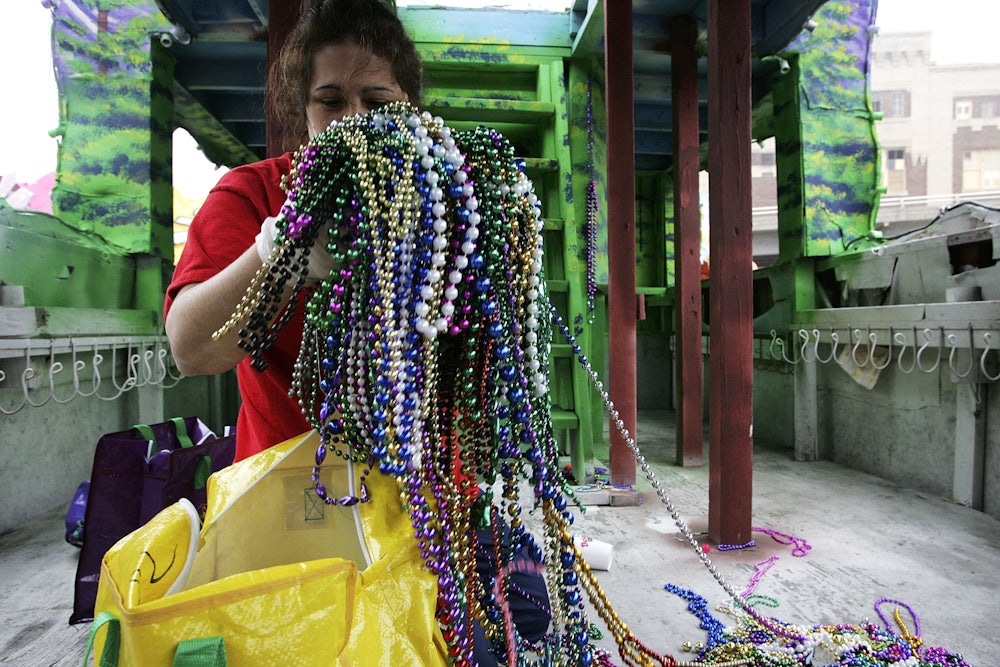Residents and businesses along the Gulf Coast may be missing the Mardi Gras festivities canceled due to the pandemic this year. The planet probably isn’t.
Shiny Mardi Gras beads used to be few in number and relatively high in quality. But in the past few decades, as numerous articles have now pointed out, the practice has gotten out of control, in a region already courting environmental disaster. Unlike other “throws” you might catch from a float, like cups and blinky toys, Mardi Gras beads aren’t safe to put in your mouth or even handle without washing your hands afterward. Last year, an Ann Arbor Ecology Center study found most Mardi Gras beads to be made of the dead electronics and computer equipment that America ships to China for disposal. Chinese companies, under more lax environmental regulations, crush and melt the electronics into beads, cover them in shiny lead paint, then ship them back to the United States glowing with neurotoxins, flame retardants, arsenic, cadmium, and other cancer-causing agents.
Environmentalists and researchers who study the Gulf are hoping cities will take the opportunity in this strangely quiet Carnival season to change how Mardi Gras is celebrated going forward. “Mardi Gras beads are polycarbonate, which is what plexiglass is made of, and it’s very dense, meaning most beads don’t float,” oceanography professor Mark C. Benfield, who studies the effect of litter on the Gulf of Mexico, told me. “A lot of the beads from the parades get into the storm drains and are pumped out into canals and bayous that drain into the Mississippi River. They drop to the bottom of the river, where they’re carried along the channel out into very deep water. Somewhere off the Mississippi Delta, there’s gotta be an enormous quantity of Mardi Gras beads sitting on the seafloor.”
New Orleans typically absorbs the fame and the blame for thousands of tons of Carnival garbage. But in fact, the entire Gulf Coast from Texas to Florida celebrates Mardi Gras by throwing poisonous beads.
American Mardi Gras was born in Mobile, Alabama, in 1703, fifteen years before New Orleans was founded. To this day, Mobile hosts parades almost every night for weeks during the pre-Lenten Carnival season, culminating on the Tuesday for which Mardi Gras is named. In 2020, Mobile’s Mystics of Time parade had 138,600 people clamoring for beads thrown from 19 floats by almost 1,000 riders. “We cleaned up One Mile Creek storm drain, and it was chockablock full of Mardi Gras beads,” said Casi Callaway of Mobile Baykeeper, an environmental group that received a grant specifically to reduce Mardi Gras waste in Mobile. “And all the way to the river we found beads, cups, little plastic footballs, and stuff, all headed to the Gulf of Mexico.”
Pensacola, Florida’s Mardi Gras last year drew around 90,000 revelers, while Carnival krewes (as the folks riding the floats are called) at Galveston, Texas’s 11-day celebration threw three million beads to around 250,000 visitors. Not to be out-trashed, the state of Mississippi’s 20 parades last year left behind 5,406 pounds of wasted beads. Anna Harris, executive director for the Coastal Mardi Gras Museum and a member of the Gulf Coast Carnival Association, which has paraded in Biloxi since 1908, estimates her krewe alone buys around $500,000 worth of beads each year to throw from its 100-plus floats. “The cleanup is a war zone,” Harris says. “It takes them a whole day to clean it all up. They have to vacuum out the storm drains.” Similar celebrations play out in most Mississippi cities: Pass Christian, Bay St. Louis, Long Beach, Ocean Springs, and Pascagoula.
Given the sheer quantity of poisonous beads dumped, all at once, year after year, along the entire Gulf Coast, Mardi Gras could be considered one of the region’s top petrochemical polluters. “The chemical levels are sublethal, but they are adding to the overall toxin loading in the Gulf’s waters,” said Dr. Benfield.
Those of us missing Mardi Gras right now can take heart that at least this year, this one little year, we aren’t adding to this massive problem. And in that pause, there’s an opportunity to work toward a greener celebration next year.
“A beadless Mardi Gras has been hard to implement krewe-wide, because our audience likes their beads,” said Maureen Shuh, recycling coordinator for Krewe of Muses, who claims that her popular ladies-only krewe is done using plastic beads.* “Through the years, we’ve been slowly making a conscious effort to decrease the number of beads, or anything that looks like beads.” The popularity of Muses’ signature throw, the hand-painted high-heel shoe, proves that homemade throws rarely end up in landfills. “All my friends give me their old shoes, we paint them, and people go crazy for them,” says Shuh, who pays $800 in dues each year to ride among 1,200 krewe members, and then spends another $1,000 on throws. “But Muses throws are all things you can take home and use. Last year we threw out bike bells, pocketbooks, cell phone cases. We only throw beads if you can wear them every day: real jewelry.”
Muses and several other large krewes are in talks with Glass Half Full, New Orleans’s only glass recycler (the city recycles only plastic and aluminum). Glass Half Full collects and recycles unwanted glass into sand and glass cullet (fine crushed glass) that is used for disaster relief projects and coastal restoration, and also to make glass Mardi Gras beads, not unlike the imported Czechoslovakian beads originally thrown at parades before the 1970s plastics explosion. “We have a waste problem with glass, and we have a waste problem with beads,” says Glass Half Full’s Franziska Trautmann. “Some of the bigger krewes don’t want to change up unless we can match China’s prices for the same volume of beads, which won’t happen, because we want to pay fair wages. But we have Muses, and Krewe of Red Beans is partnering with us. Rex, the ‘King of Carnival,’ is a potential buyer. People are waking up and getting on board.”
In the last several years, many small, eco-friendly, local bead companies have popped up, such as Bayou Throws and Atlas Handmade Beads. Scientists at Louisiana State University even developed biodegradable Mardi Gras beads made from algae. Concerned krewes also try to throw goodies that people will keep: Some krewes talk of switching from beads to wooden doubloon coins that people can cash in with local businesses, as Popeyes chicken restaurant did in the 1970s. The company Grounds Krewe sells green throws like jute sacks of local coffee, rice, and jambalaya mix.
Most of these alternatives have been around for a while now, though, and I’ve still never caught any algae beads along the parade routes. For now, the krewes still prefer the cheap, useless fireworks display of poisonous polycarbonates.
New Orleans city government never discusses a ban on these beads. Recycling still seems like the only “solution” most city governments are willing to try. Every city along the Gulf Coast collects used beads at the post office, library, or City Hall. The Arc of Greater New Orleans hires adults with developmental disabilities to refurbish and repackage used beads to be resold to krewes. Recycling, though, just keeps the poisonous beads in rotation.
All these beads continue to land upon a region already suffering under the thumb of Big Oil. And the threat of hurricanes. And sea-level rise. And a 6,000–7,000-square-mile “dead zone” in the Gulf where almost no living thing can breathe. One of Dr. Benfield’s colleagues at LSU, Stephen Midway, has discovered high levels of polyethylene in both Louisiana seafood and Mardi Gras beads.
Coronavirus may not have too many upsides, but for this one year, the Gulf Coast isn’t throwing millions of tons of poisonous beads into landfills and waterways. For just this one year, we don’t have to tell our kids, “Don’t put that in your mouth!” For this one year, we are not exacerbating the massive environmental problem along the banks of America’s most beautiful water body. Surely that feeling is worth a few policy changes, so that Mardi Gras is a bit less toxic when it returns.
*This sentence has been corrected. Maureen Shuh is a krewe member and reducing/reusing/recycling coordinator for Krewe of Muses, not the krewe’s captain.








